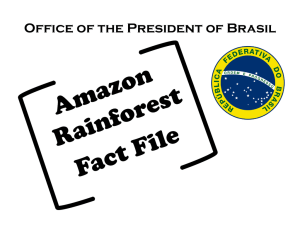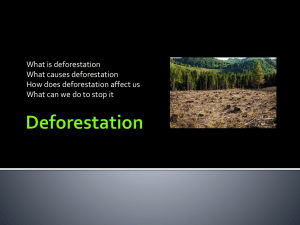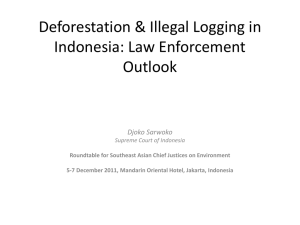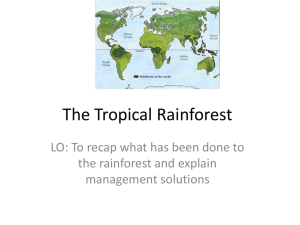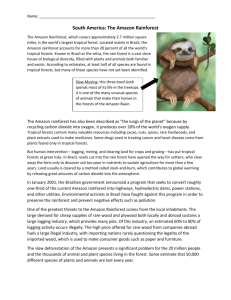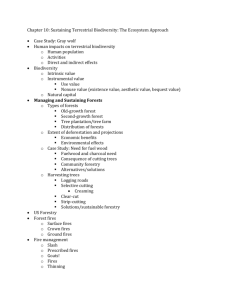Ex11 PeopleVsTRF_ans - S1OrtusGeog
advertisement
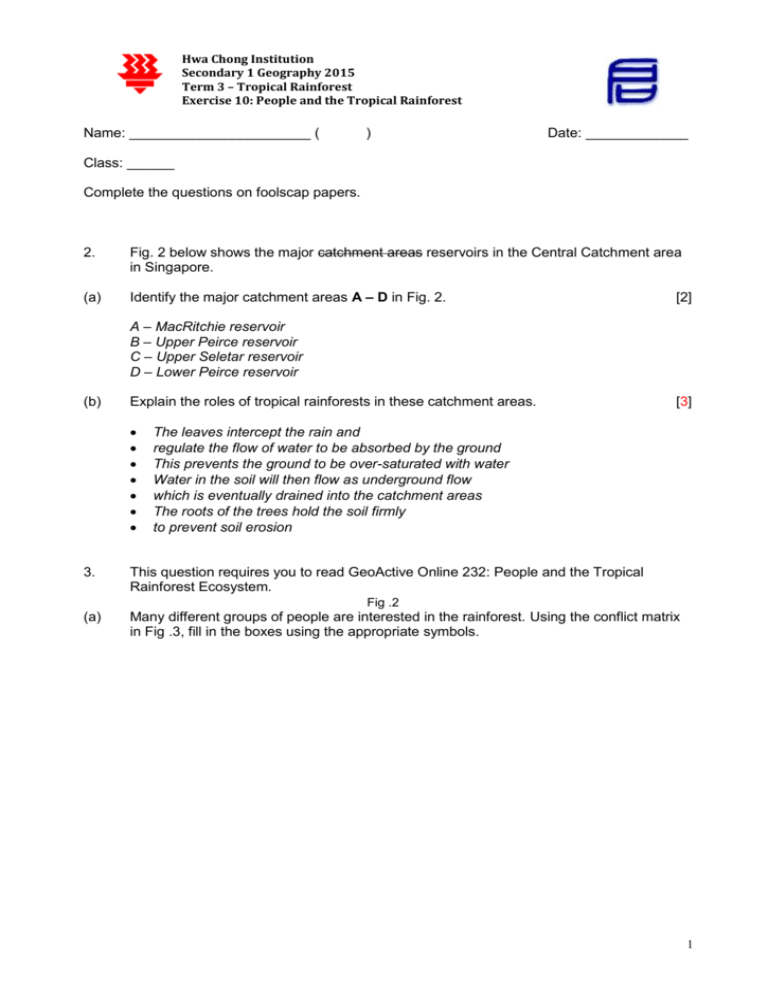
Hwa Chong Institution Secondary 1 Geography 2015 Term 3 – Tropical Rainforest Exercise 10: People and the Tropical Rainforest Name: _______________________ ( ) Date: _____________ Class: ______ Complete the questions on foolscap papers. 2. Fig. 2 below shows the major catchment areas reservoirs in the Central Catchment area in Singapore. (a) Identify the major catchment areas A – D in Fig. 2. [2] A – MacRitchie reservoir B – Upper Peirce reservoir C – Upper Seletar reservoir D – Lower Peirce reservoir (b) Explain the roles of tropical rainforests in these catchment areas. [3] The leaves intercept the rain and regulate the flow of water to be absorbed by the ground This prevents the ground to be over-saturated with water Water in the soil will then flow as underground flow which is eventually drained into the catchment areas The roots of the trees hold the soil firmly to prevent soil erosion 3. This question requires you to read GeoActive Online 232: People and the Tropical Rainforest Ecosystem. (a) Many different groups of people are interested in the rainforest. Using the conflict matrix in Fig .3, fill in the boxes using the appropriate symbols. Fig .2 1 Fig. 3 (Source: GeoActive Online 232) (b) Choose two groups that live in harmony. Explain your answers. Indigenous and wildlife. The indigenous people do not pose a serious threat to the wildlife. Although they do hunt for wildlife, they only take what is necessary. Generally, the indigenous people live harmoniously with nature. (c) Choose two groups that you have shown to be in conflict. Explain the reasons for this conflict. Loggers and Indigenous. Loggers disturb the peace and tranquility of the forest which the indigenous see as intrusion of their ‘property’. Logging activities have not only resulted in the lost of wildlife but have also disrupted the lives of the indigenous people. These indigenous people have to move further into the forest or are forced to resettled in other areas. (d) How would you suggest that the conflicts you identified in (c) could be reduced? Set up protected areas to conserve the forest. Impose hefty fines to logging companies which carry out deforestation in the protected areas. Control the amount of timber cut down by the loggers by designating areas for them to carry out their activities. Resettle the indigenous people in villages and provide them with a source of income such as farming. 2 Open-ended essay (5 marks each) 1. Logging is the main cause of deforestation in most countries. How far do you agree? [5] Logging refers to the cutting down of trees for timber. Commercial logging of tropical hardwoods is a major cause of deforestation in Southeast Asia and Africa. Examples of tropical hardwoods are teak, mahogany and rosewood. The timber is used to make furniture, building materials and charcoal. Growing demand for timber products increases logging activities. Globally, commercial logging is responsible for destroying 50,000 square kilometres of tropical rainforest every year. Logging not only reduces the number of trees but damages the rainforest as a whole. For every tree extracted, five are badly damaged because the falling tree will destroy the surrounding trees or smaller-sized plants. The removal of the tree also leaves the soil exposed to erosion. For example, in China's huge demand for timber for making disposable chopsticks and paper has resulted in heavy logging in the rainforests of Congo and Cameroon in Central Africa, Brazil and Indonesia. The rate of deforestation increased greatly with the introduction of large-scale commercial agricultural activities on plantations. These plantations are obtained by burning and clearing large areas of the rainforest. The crops from plantations are grown for cash and are sold to meet both local and global needs. For example, By 2010, about 242,000 square kilometres of the Amazon rainforest have been converted into soya bean farms. Besides being a major ingredient in food for cattle, soya beans are also processed into products such as soya milk and tofu. In Borneo and Sumatra, large areas of rainforest are converted into commercial oil palm plantations. Many everyday products contain palm oil such as ice cream, chocolate, chips, soap, toothpaste and even pet food contain palm oil. In conclusion, logging is not the main cause of deforestation. With the world’s population growing rapidly, more food is needed and hence it is inevitable that more forests will be removed for agricultural activities such as plantations and cattle ranching. Countries with forest resource should practise sustainable forestry to ensure the forest will not be wiped out totally in decades to come. 2. Deforestation brings more problems than benefits. Do you agree? Explain. [5] Use the PEEL approach Impacts of deforestation can be classified into mainly economic and social impacts. Deforestation is carried out on a large-scale in less developed countries (LDCs). For example, Brazil, a less developed country, has borrowed money from the DCs in the 1960s and 1970s it to help it build roads, bridges, railways, all of which are needed for development to take place. The revenue generated from the sale of timber from logging is used to repay its debt. In addition, forest is cleared to create more agriculural land. For example, in Brazil, about 80% of the cleared areas are used for cattle ranching which generates huge revenue for the country. In East Malaysia, large tract of deforested land has been sold to oil palm plantation owners. Deforestation, has largely benefited the LDCs with more revenue and more land for development. However, large scale deforestation has led to climate change and consequently, there are more occurances of weather related disasters such as heat wave, snow storms and hurricanes. For example, the snow storm in early 2014 had cost USA a lot of revenue due to economic standstill. With climate change intensifying, there are more occurances of such weather-related disasters, costing governments from DCs and LDCs billions of dollars. Hence, in the long run, these countries may lose revenue more than they have gained. The economic benefits brought about by deforestation in less developed countries have led to better standard of living of the people in these countries. Forested land cleared for industrial or agricultural purpose have provided jobs and incomes for many people. However, the indigenous people who live in the forest are victims of deforestation carried out in the name of development. The forests are home to many indigenous people. It is estimated that there were once 10 million Indians living in the Amazon forest. There are now fewer than 200,000. The indigenous tribes, such as the Waorani and Kayapo in South America, have lived in the rainforests for thousands of years. They hunted, fished and grew a variety of crops in small 3 gardens. Everything they needed to survive, including food, clothes and medicines came from the forest. If the forests are not conserved, the rapid rate of deforestation would definitely threaten their survival. Thus, it can be seen that deforestation seemed to benefit the majority of the population in LDCs as the indigenous people forms the minority. To conclude, I agree to a large extent that deforestation brings more problems than benefits. Although there will be economic gains through the sale of timber and other mineral ores, these gains are short-termed. However, when the forests are depleted and habitats destroyed, it is impossible to return to the original state again. The forest is home to many indigenous tribes. The government of these countries should designate certain areas as indigenous reserves where logging is strictly prohibited. In addition, sustainable forestry should be implemented to ensure the forests have sufficient time to regrow. 4

